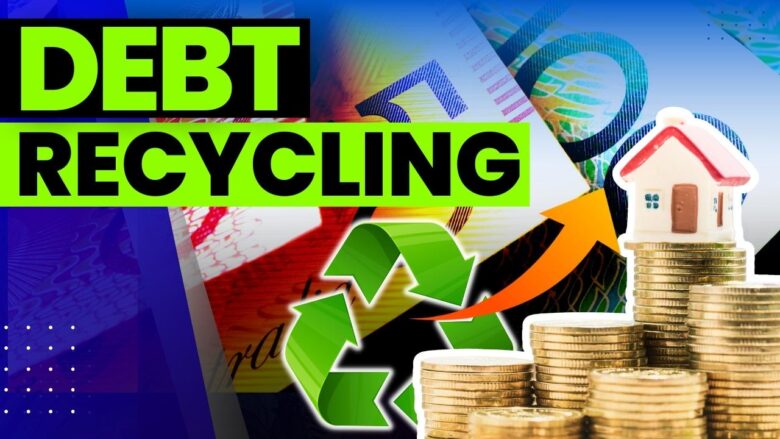Debt recycling is a powerful financial strategy that can help individuals maximize returns and achieve financial success. By understanding the concept of debt recycling, its role in financial success, and the steps to implement it effectively, individuals can leverage their existing debts to create wealth and improve their financial health.
Understanding the Concept of Debt Recycling
Debt recycling is a strategy that involves using the equity within an individual’s property to invest in income-generating assets. The goal of debt recycling explained, is to generate additional income, which can be used to pay off non-deductible debts while increasing the overall wealth of the individual.
Debt recycling is a powerful financial technique that can help individuals optimize their wealth creation and tax efficiency. By strategically redirecting existing non-deductible debt towards deductible debt, individuals can leverage their assets to generate additional income and reduce their overall tax liabilities.
The Basics of Debt Recycling
At its core, debt recycling involves redirecting existing non-deductible debt, such as a mortgage or personal loan, towards deductible debt by utilizing the borrowed funds to invest in income-producing assets. This approach allows individuals to offset their income and reduce their overall tax liabilities.
By refinancing their existing non-deductible debt, individuals can unlock the equity within their property and use it as leverage to invest in assets that generate income. This strategy creates a virtuous cycle where the income generated from the investments is used to pay off non-deductible debts, while the overall wealth of the individual continues to grow.

How Debt Recycling Works
To implement debt recycling, individuals need to refinance their existing non-deductible debt and unlock the equity within their property. This equity can then be used as leverage to invest in assets such as shares, managed funds, or property that generate income.
By carefully selecting income-generating assets, individuals can ensure that the returns from their investments are greater than the interest paid on the borrowed funds. This allows them to generate a positive cash flow, which can be used to pay off non-deductible debts faster and accelerate the growth of their overall wealth.
Debt recycling requires careful planning and consideration of various factors such as interest rates, investment returns, and tax implications. It is important for individuals to seek professional advice from financial experts who can help them navigate the complexities of this strategy and tailor it to their specific financial goals and circumstances.
Overall, debt recycling is a powerful wealth creation strategy that allows individuals to optimize their financial position by leveraging their assets and generating additional income. By strategically redirecting non-deductible debt towards deductible debt, individuals can reduce their tax liabilities while increasing their overall wealth. However, it is important to approach debt recycling with caution and seek professional advice to ensure its suitability and effectiveness in individual cases.
The Role of Debt Recycling in Financial Success
Debt recycling plays a crucial role in helping individuals achieve financial success by acting as a wealth creation strategy and improving overall financial health.
When it comes to managing finances, individuals often seek strategies that can help them maximize their wealth and secure a stable financial future. Debt recycling is one such strategy that has gained popularity in recent years. By understanding the concept and implementing it effectively, individuals can unlock a world of financial opportunities.
Debt Recycling as a Wealth Creation Strategy
By redirecting non-deductible debt towards income-generating assets, individuals can create a source of passive income that has the potential to grow exponentially over time. This can significantly contribute to wealth accumulation and financial independence.
Imagine a scenario where an individual has a mortgage on their primary residence, which is considered non-deductible debt. By utilizing debt recycling, they can strategically borrow against the equity in their home and invest that borrowed money into income-generating assets such as shares, managed funds, or investment properties. This effectively transforms their non-deductible debt into deductible debt, allowing them to claim tax deductions on the interest paid.
As the income-generating assets grow in value and generate returns, the individual can use those returns to pay off their non-deductible debt faster. This creates a cycle of debt repayment and investment, hence the term “debt recycling.” Over time, the individual can build a portfolio of income-generating assets that not only provide a steady stream of passive income but also appreciate in value, further enhancing their wealth.
The Impact of Debt Recycling on Financial Health
Implementing debt recycling can improve financial health by allowing individuals to optimize their tax position and reduce their overall debt burden. By reducing non-deductible debt and increasing deductible debt, individuals can effectively manage their financial obligations while building wealth.
One of the key benefits of debt recycling is the ability to optimize tax deductions. By converting non-deductible debt into deductible debt, individuals can claim tax deductions on the interest paid, effectively reducing their taxable income. This can result in significant tax savings, freeing up more funds to invest or pay off debt.
Furthermore, debt recycling can help individuals reduce their overall debt burden. By strategically utilizing borrowed funds to pay off non-deductible debt, individuals can accelerate their debt repayment journey. This not only reduces the amount of interest paid over time but also shortens the overall duration of debt repayment, allowing individuals to become debt-free sooner.
It is important to note that debt recycling is not without risks. As with any investment strategy, there are potential pitfalls that individuals should be aware of, such as market fluctuations and interest rate changes. Therefore, it is crucial to seek professional financial advice and carefully assess one’s financial situation before embarking on a debt recycling journey.

In conclusion, debt recycling is a powerful strategy that can help individuals achieve financial success. By transforming non-deductible debt into deductible debt and strategically investing in income-generating assets, individuals can create a path towards wealth accumulation and financial independence. However, it is essential to approach debt recycling with caution and seek expert guidance to mitigate risks and maximize the potential benefits.
Steps to Implement Debt Recycling
Implementing debt recycling requires careful planning and consideration. The following steps outline the process of implementing this powerful financial strategy:
Evaluating Your Financial Situation
Before embarking on the debt recycling journey, it is essential to assess your current financial situation. This involves understanding your income, expenses, existing debts, and the equity within your property. By gaining a clear understanding of your financial position, you can determine if debt recycling is a suitable strategy for you.
During the evaluation process, it is important to take a comprehensive look at your income sources. This includes analyzing your salary, investments, and any other sources of income you may have. By understanding your income, you can determine how much you can allocate towards debt recycling.
Additionally, evaluating your expenses is crucial in determining your financial capacity for debt recycling. This involves categorizing your expenses into essential and non-essential items. By identifying areas where you can potentially reduce your spending, you can free up more funds to allocate towards debt repayment.
Furthermore, assessing your existing debts is an integral part of evaluating your financial situation. This includes gathering information about your outstanding loans, credit card balances, and any other forms of debt. By understanding the interest rates, repayment terms, and monthly payments associated with each debt, you can determine which debts are suitable for debt recycling.
Lastly, evaluating the equity within your property is essential in determining the potential for debt recycling. This involves obtaining a property valuation and subtracting any outstanding mortgage balances. By understanding the equity available, you can determine how much you can potentially borrow against your property for investment purposes.
Developing a Debt Recycling Plan
Creating a debt recycling plan involves determining how much equity you can access, identifying suitable income-generating assets to invest in, and targeting a specific timeframe for debt repayment. It is crucial to work with a financial advisor who can help you develop a tailored plan that aligns with your financial goals and risk tolerance.
When determining how much equity you can access, it is important to consider factors such as loan-to-value ratios, lending criteria, and the potential impact on your property’s value. By working with a financial advisor, you can navigate through these considerations and determine the optimal amount of equity to borrow against your property.
Identifying suitable income-generating assets is another crucial step in developing a debt recycling plan. This involves researching and analyzing different investment options such as shares, managed funds, or property. By considering factors such as potential returns, risks, and diversification, you can select assets that align with your financial goals and risk tolerance.
Furthermore, targeting a specific timeframe for debt repayment is essential in creating a debt recycling plan. This involves setting realistic goals and milestones to track your progress. By breaking down your debt repayment into manageable chunks, you can stay motivated and focused on achieving your financial objectives.
Working with a financial advisor throughout the process of developing a debt recycling plan is highly recommended. A financial advisor can provide expert guidance, help you navigate through complex financial concepts, and ensure that your plan is tailored to your unique circumstances.

Risks and Rewards of Debt Recycling
Like any financial strategy, debt recycling carries both potential risks and rewards. Understanding these can help individuals make informed decisions and mitigate potential pitfalls.
Potential Risks in Debt Recycling
One of the primary risks of debt recycling is the potential for investment losses. As with any investment, there is always a degree of volatility and uncertainty. It is crucial to carefully research and diversify your investments to mitigate these risks.
The Rewards of Effective Debt Recycling
When implemented effectively, debt recycling can yield significant rewards. By generating additional income from income-generating assets, individuals can accelerate debt repayment, build wealth, and improve their overall financial situation.
Tips for Maximizing Returns with Debt Recycling
To maximize returns and ensure the success of debt recycling, individuals should follow certain best practices while avoiding common pitfalls.
Best Practices for Debt Recycling
Firstly, it is important to seek professional financial advice to ensure that debt recycling aligns with your financial goals and circumstances. Additionally, regularly reviewing and adjusting your debt recycling plan to reflect changes in your income, expenses, and assets is crucial to maintain its effectiveness.
Avoiding Common Pitfalls in Debt Recycling
One of the common pitfalls of debt recycling is becoming overly focused on investment returns and neglecting debt repayment. It is essential to strike a balance between investing in income-generating assets and reducing non-deductible debt to maximize the long-term benefits of debt recycling.
In conclusion, debt recycling is a powerful strategy that individuals can use to maximize returns, create wealth, and achieve financial success. By properly understanding the concept, implementing the necessary steps, and being aware of the associated risks and rewards, individuals can effectively leverage their debts to create a secure and prosperous financial future.
More to read: Key Principles for a Smart and Strategic Approach

